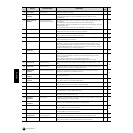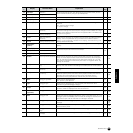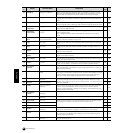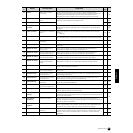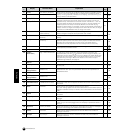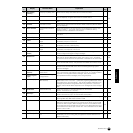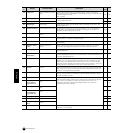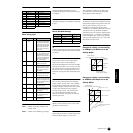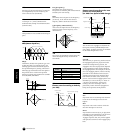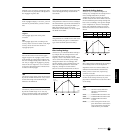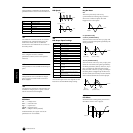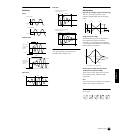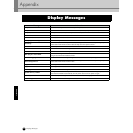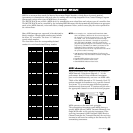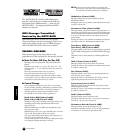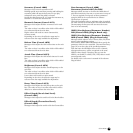
72
Reference
*15
Send level (to Reverb and Chorus) cannot be
set independently for each Drum key; the
value is fixed at 127 (maximum).
*16
A setting of “C” (center) maintains the
individual Pan settings of each Element/Part
(Common edit).
*17
This parameter is not available for the Plug-in
parts.
*18
MEQ (Master Equalizer)
Shape
Determines whether the equalizer type used
is Shelving (shelv) or Peaking (peak). The
Peaking type attenuates/boosts the signal at
the specified Frequency setting, whereas the
Shelving type attenuates/boosts the signal at
frequencies above or below the specified
Frequency setting. This parameter is available
for LOW, MID, and HIGH.
Freq (Frequency)
Determines the center frequency.
Frequencies around this point are attenuated/
boosted by the Gain setting.
Gain
Determines the level gain for the Frequency
(set above), or the amount the selected
frequency band is attenuated or boosted.
Q (Frequency Characteristic)
This varies the signal level at the Frequency
setting to create various frequency curve
characteristics.
*19
You can set the parameters related Voice only
when entering the Utility mode from the
Voice mode.
*20
*21
Element control according to Velocity
(ex. PEG)
*22
Element control according to the note
position on the keyboard
(ex. PEG Time: Speed of PEG change)
*23
You can also turn Arpeggio on/off from the
front panel with the [ARPEGGIO] button
(Voice Edit). Arpeggio Switch is not available
for the Multi Plug-in Parts 17-32.
*24
sync-off
The first time you press a key, the first note of
the arpeggiator pattern is played. From the
second and subsequent key presses, the
arpeggiator note that is played back depends
on the arpeggiator tempo and the timing of
the arpeggio pattern. For example, in the case
of a 1-bar arpeggio pattern, if the second key
press falls on the third beat of the bar, the
arpeggio pattern plays back from the third
beat onward. In other words, the first key
press is used to start the arpeggio pattern and
thereafter you can use the key to “mute” or
“un-mute” the pattern by, respectively,
holding it down or releasing it. This is
particularly useful when the arpeggiator is
being used to generate drum patterns.
*25
sort
Plays back notes in ascending order from the
lowest Note On message received to the
highest.
thru
Plays back notes in the order in which the
Note On messages are received.
direct
Plays back the notes exactly as you play them.
If changes to Voice parameters (such as Pan or
Cutoff frequency) are included in the
Arpeggio sequence data, they will be applied
and reproduced whenever the Arpeggio plays
back.
LOW
5 bands
HIGHHIGHMIDMIDLOWMID
Q(Frequency Characteristic)
Gain
Freq
(
Frequency
)
0
Gain
Freq
–
+
0
–
+
0
EQ Low
Freq1
EQ Low
Freq2
shelv
peak
Frequency
Frequency
Settings
(Display)
Available Segment for EGTime
atk attack time
atk+dcy attack time/decay time
dcy decay time
atk+rls attack time/release time
all all time
–
+
0
0.1
12.0
Freq
Frequency
Large
Velocity
Positive value
Amount of pitch change
Time of PEG change
Slower speed
Faster speed Large
EGTime EGLevel
Small
Small
Basic pitch (center Key)
Positive value
Higher range
Lower range
Slower speed
Faster speed
+63
+30
-40
Negative value
Function List



